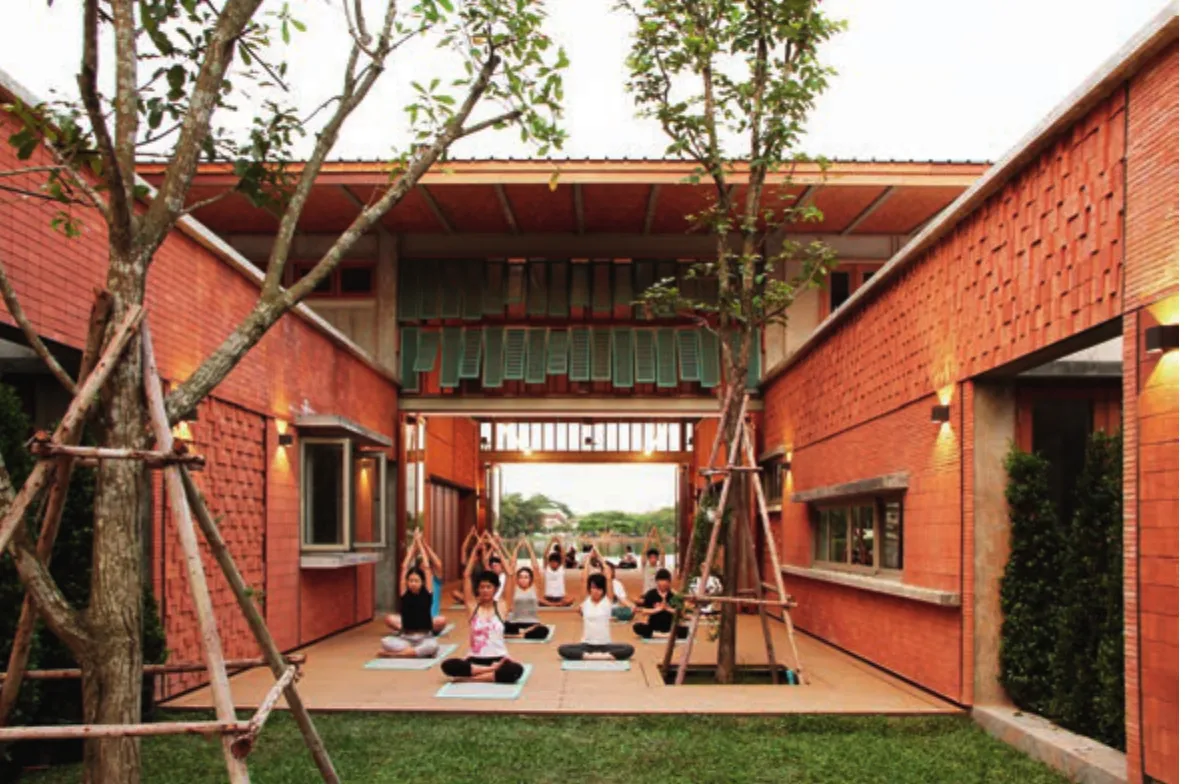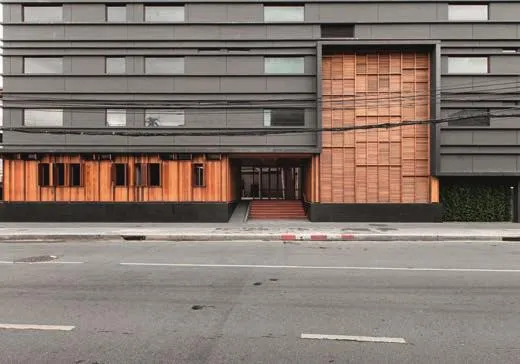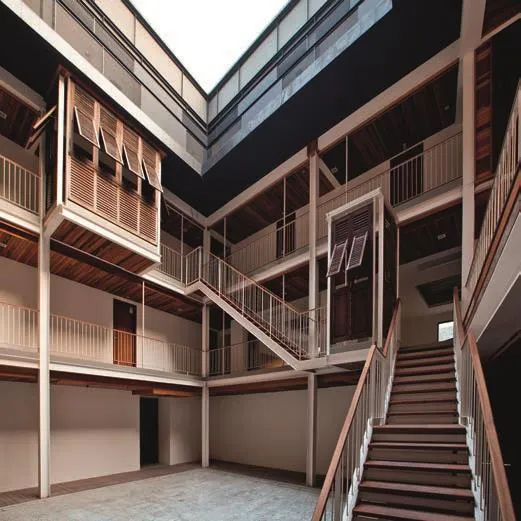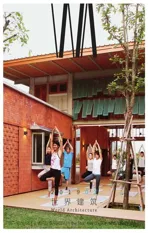“热带杂交体”
——为亚洲热带地区无法控制的城市化进程设计的适应性赤道地区建筑
2019-04-19查蓬楚恩鲁迪莫尔ChatpongChuenrudeemol
查蓬·楚恩鲁迪莫尔/Chatpong Chuenrudeemol
徐知兰 译/Translated by XU Zhilan
2019年的曼谷正面临社会、政治和环境的危机。城市、郊区和农村地区的发展正在快速增长,主要由私人企业、房地产投机和国际旅游业推动。所有层级的政府机构都尚未跟上步调,并且在很多情况下,在这场肆无忌惮的开发进程中与上述商业机构沆瀣一气。这种呈指数级的增长也同时深刻地改变了我们所谓的热带城市的外部环境和内在基因。在外部环境方面,全球市场的力量和随之而来的全球建筑语汇使亚洲的大城市变得均质化。
曼谷是吉隆坡是雅加达是万象是仰光是胡志明市。
审视内部因素,我们充分意识到了城市化进程带来的社会、经济和环境问题——污染、拥挤、犯罪、贫困、基础设施匮乏、几无所剩的经济住宅、以及自然灾害期间的灾难扩大效应等,却仍比不上我们在21世纪前25年内所见证的程度。尽管这些现象遍及全球,但考虑到东南亚热带地区特殊的环境、气候条件和文化背景,我们所受的影响独一无二。
在过去几十年间,新一代的东南亚地区建筑师已经从现代热带地区建筑的历史人物中获得了宝贵的经验,如杰弗里·巴瓦和科瑞·希尔。他们的作品是无价之宝,为我们奠定了当代热带地区建筑的基础知识框架。然而,尽管这些大师的杰作具有启蒙意义,他们仍受限于自身程式化和语境主义的要求。大部分著名的热带建筑代表作都是坐落在自然环境中、空间宽敞的高端住宅和奢华度假村,不受城市复杂环境的任何影响。当地设计师对这些大师作品的盲目欣赏经常导致热带地区建筑设计的策略错误,尤其是那些位于极端城市环境中的建筑。我们对过于外部化的热带地区建筑已经司空见惯,它们有宏伟的沿街空间、面向室外开敞的门厅沙发,却令人怀疑地引入所有的外部城市空间要素——尘埃、烟雾,以及震耳欲聋的交通噪音。另一个同样危险的极端可能来自于一种人为设定的“热带风格”建筑外观样式——木檩条、绿植墙、铝制散热片——实际上却是密不透风的封闭式空调箱。
因此我们能很确信地说,许多东南亚的建筑师仍在迷信着“热带的神话”,采用着过时的热带建筑设计策略。其结果就是,我们仍在为失落的热带天堂设计虚假的建筑。
事实上,位于极端城市环境——即四处蔓延的郊区(城市化的郊区环境)和被侵蚀的乡村地区中的综合功能建筑设计任务正在大量增加。陈旧的热带建筑设计锦囊无法帮助我们接受这些挑战。作为回应,我们必须把热带建筑设计的理念和策略从过去自然浪漫主义的原型推向适应性更良好、空间流畅的热带地区建筑杂交体,让它能有效地关联新的热带地区城市空间。
1 新的热带地区城市
如果亚洲的热带地区意味着高度全球化和高密度的城市尺度,我们作为建筑师就必须重新考虑热带建筑的场所、意义和设计策略。
对我来说,像曼谷之类热带地区城市的当代设计状况表现出难以置信的复杂挑战。相比曼谷在仅仅10年或15年前的情况,这座城市现在的开发强度更高、污染更严重、交通更拥堵且正陷于日益复杂的全球经济和政治体系中。东南亚热带地区的其他大部分主要城市也大多同样如此。因此,传统的热带建筑设计策略不再完全适用于新的赤道地区大城市环境。
过去,热带环境建设致力于遮蔽强烈的阳光和阻隔季节性降水,但也尽可能加强室内的通风。从树木瑟瑟的摇曳声到啾啾鸟鸣,大自然的声响总是很受欢迎。在今天亚洲热带地区的大城市中,“大自然母亲”的声音早已被城市摩托计程车和推土机刺耳的喧嚣声吞没。空气中开始充斥着由那些噪音制造者的活动所产生的致命微小颗粒。室外空气不再受人欢迎,其中的CO含量与日俱增。每当城市中微风拂过,仅需要几小时,所有室内表面都会堆积起层层灰土。被封闭在你那密不透风的大楼里不仅是为了维持室温,也是为了把自然界的空气阻隔在外面!
在像孟买、雅加达和曼谷这样的热带地区大城市,空气质量都只能徘徊在几乎致命的水平。“曼谷空气质量指数”显示可吸入肺颗粒浓度——也就是某些直径小于10μm的致癌污染物质微粒的浓度——日均数值高达190(推荐的全球安全均值是25)。于是现在的曼谷人只能在街上戴起口罩,让这座过去曾属于“热带地区”的城市显现出一幅末日后的景象(不幸的是,对许多中国和印度大城市的居民来说,这番景象已在过去10年间成为新的日常习惯。)。城市空气质量的问题是我们对亚洲城市热带建筑设计原则的探讨中的核心问题。
Bangkok of 2019 is in a state of social, political,and environmental crises. Urban, suburban, and rural development is accelerating at increasing speed,spurned on mainly by private industry, real estate speculation, and global tourism. Governmental institutions, at all levels, are not equipped to keep pace, and many times, are complicit in this rampant,uncontrolled development. This exponential growth has had a profound effect on changing both the external pro fi le and internal DNA of what we call the tropical city. On the outside, global market forces and the accompanying Global Architectural language have homogenised the Asian metropolis…
Bangkok is Kuala Lumpur is Jakarta is Vientien is Yongoon is Ho Chi Min City.
Internally, we are well aware of the social,economic, and environmental sickness that come with urbanisation - pollution, congestion, crime,poverty, inadequate infrastructure, depleted affordable housing, and amplified catastrophic effects during natural disasters… but never at the levels we have witnessed in the first quarter of the 21st century. Although these phenomena are occurring in every part of the world, their effects on the Southeast Asian Tropics are unique, due to our specific environment, climate, and culture.
Over recent decades, the new crop of Southeast Asian architects has learned valuable lessons from historical figures of modern tropical architecture,like Geoffrey Bawa and Kerry Hill. Their bodies of work were invaluable in helping us form the foundational knowledge of contemporary tropical architecture. However, as enlightening as these master works are, they are still limited in their programmatic and contextual demands. Most celebrated tropical canons are comprised mostly of high-end residences and luxurious resorts, situated largely in natural settings unencumbered by urban complexities. The unchecked adoration of local designers for these masterworks has frequently resulted in the misappropriation of tropical strategies, particularly in contexts of extreme urbanism. How often have we seen the overly externalised tropical building, with wonderful street-side, open-air lobby lounge that dubiously invite in all the external urban elements - dust,fumes, and the rumble of the street traffic. The other extreme, ever just as dangerous, may come in the form of a building that assumes a "tropical"appearance - wood slats, green wall, aluminum fins - but are essentially hermetically sealed airconditioned boxes.
We can therefor safely say that many architects in Southeast Asia still hold onto the myth of the tropics and employ outmoded strategies of tropical architecture. As a result, we are still designing a false architecture for a lost tropical paradise.
In reality, commissions for buildings with hybrid programs, located in sites of extreme urbanity… sprawling sub-urbanity (an urbanised suburban condition)… and encroached rurality are on the rise. Our old tropical bag-of-tricks do not equip us to meet these challenges. In response we must push tropical design ideologies and strategies past natural romantic archetypes to more adaptive and fl uid tropical hybrids that effectively engage the new tropical urbanism.
1 A New urbanised tropicality
As the Asian Tropics assume a hyper globalised and intensely urban dimension, we as architects must rethink the context, meaning, and strategies of tropical architecture.
For me, the reality of designing in the contemporary Asian tropical metropolis like Bangkok presents an incredibly complex challenge.The city is more developed, more polluted, more congested, and entangled in increasingly complex economic and political glocal systems, compared to the Bangkok of only ten or fifteen years past.This much can be said of most major tropical metropolises in Southeast Asian region. As such,traditional tropical design strategies are not so readily applicable to the new equatorial metropolis.
In the past, tropical environments aimed to filter the harsh sun and monsoon rains, but endeavored to move as much air through its interiors as possible. Sounds of nature from the rustling of trees to chirping of birds were welcome guests. In today's Asian tropical metropolis, the sounds of Mother Nature have long been engulfed by the urban cacophony of motorcycle taxis and bulldozers. The air has become saturated with deadly micro particles from the activity of those very noisemakers. Outside air is no longer a welcome guest with heavier doses of CO. City breezes sweeps in urban dust that accumulate in layers on all interior surfaces in a matter of hours. Being hermetically sealed in your building is not just about keeping conditioned air in,but tainted natural air OUT!
Air quality in tropical metropolis like Mumbai,Jakarta, and Bangkok is on the verge of being deadly. Air Quality Index Bangkok shows PM 2.5 level reading, or particulate pollution of cancercausing micro-particles smaller than 10um, are up to 190 on a daily basis (the recommended global safety average is 25). Bangkokians are now forced to don the PM 2.5 mask while walking the streets, painting a post-apocalyptic picture of this once "tropical"city (Unfortunately, to many living in metropolitan China and India, this had been the new norm for the past decade.). The issue of urban air quality is very a core issue in our discussion of tropical design principles in the Asian city.
If we are to assume that one of the main directives of tropical design principles is "to maximise natural air flow and ventilation to achieve thermal comfort", then we have reached a serious dilemma:
How do we naturally ventilate our buildings when the very air we are inviting in is, in fact, toxic?
The new tropical architecture must now confront the many demands of this new untamed Tropical Asian city, bursting at the seams. Equatorial architecture must flex its muscles by moving beyond the romantic honeymoon phase to become the tropical sentry that effectively negotiates the contaminated nature and untamed urbanism of the new Tropical Metropolis.
如果我们假设热带建筑设计的主要指导原则之一是“最大程度促进自然通风和换气,以实现热舒适功能”,那么就会面临严重的矛盾:
我们应该如何以自然的方式实现建筑通风?如果我们引入的空气恰恰实际上……是有毒物质呢?
新的热带地区建筑设计现在必须面对新的、失控的亚洲热带地区城市这一暴增的需求。赤道地区的建筑必须超越浪漫蜜月的阶段,成为赤道地区的哨兵,使其肌肉得到放松,才能在受到污染的自然和新兴热带地区大城市不受控制的城市化进程之间进行有效地平衡。
2 具有社会包容性的热带地区项目
亚洲热带地区建筑的功能设计必须更具包容性。在住宅和度假设施建筑之外,热带建筑的设计原则必须重新审视如何为亚洲城市中的低收入阶层提供住宅、供给和必要的生存条件。
在曼谷,我们正在经历整个东南亚地区低收入阶层在热带地区城市空间形态方面的大幅度削弱。当地的菜市场(talad sod)、户外跳蚤市场 (talad naht)、传统棚屋社区(chum chon)都逐渐从曼谷的街景中消失。这在很大程度上与人们对这些较低阶层的热带城市空间类型的误解报以回避、忽视和毫不顾忌的态度有关,从而把它们当做贫民窟建筑和城市的眼中钉来对待。但它们是为曼谷底层劳动阶层提供住宅、供给和维持生计的重要载体,却正从曼谷的景观和泰国的文化意识中迅速消失,令人悲叹。
除了它们的文化和社会价值,我们还需要从经济学的角度考虑这些正在消失的本土建筑类型对城市经济等级制度具有的重要意义。我们不禁要问:“如果这些空间形态被高端住宅和购物商场所替代,那么劳动阶层将在哪里生活、饮食、消费和住宿?”照此推理,会由谁来擦洗桌面、整理货架、打扫街道和为占据了这些全球城市开发空间的中上阶层人士提供高级公寓的清洁服务?当前对现有热带城市建筑类型的搬迁/拆毁已经导致城市较低阶层居民的迁徙,反过来也导致灾难性的经济不平衡状况。考虑到这一现实状况,我们必须提问,即热带地区建筑的经验将如何延伸,为亚洲大城市中更底层的劳动阶层提供新的热带地区城市空间类型?
3 传统泰式住宅:热带地区生存的杂交体模型
回顾历史,泰国的农业景观及其附近的森林地区在很大程度一直被其所有者同时视为令人欢迎的资源提供者和凶残的敌人。河流为水稻种植提供人们需要的充沛水源,却也同时在雨季造成频繁的洪灾,轻易摧毁他们一整年的收成。人们从森林砍伐木料用于建造住宅和雕刻器物,同时森林也是野生哺乳动物和爬行动物的栖息地,它们常常是农庄的野蛮侵袭者。由农民和当地寺庙僧侣共同构成的社区邻里在任何一天都能快速地共享幸运的收获,从稻米到蔬菜、织布以及偶尔由水牛来耕作田地的机会。但在社区内部,总有意图可疑的人。尤其是在遭遇战争、干旱、洪水和其他自然或人为灾害的时候,乞丐、骗子和小偷纷纷出动。
传统的泰式高跷房屋,或称泰式“巴恩鲁恩”,也因此被理解为是一种用来抵御既丰饶、又令人无法释怀的泰国自然环境的建筑类型。这一类型在我们的邻国也有类似的体现——老挝的“胡恩劳”、缅甸的湖中浮屋、马来西亚的“昆蓬”民居,以及印度尼西亚的巴塔克式建筑 。
泰式“巴恩鲁恩”房屋在许多方面非常适合热带的自然环境。
由木构件建造的轻质预制结构、木板和压条的嵌板、藤制、竹制或木制的板条填充构件,以及茅草屋顶等构造,让建筑物能在泰国的热带气候中进行呼吸顺畅。高耸的坡屋顶能让雨季降水迅速蒸发,在山墙面上大面积开洞并覆盖百叶窗能在潮湿的环境中加速屋顶通风。在“代敦”处——也就是传统架空房屋中部下方有树荫遮蔽的空间,室内外空间有非常明显的相互重叠。白天,未在水稻田间劳作的家庭成员就在此处躲避强烈的日照或热带的降雨。这处奇妙的空间条件由3个最简洁的元素构成——下方肮脏的泥地、上方的木质地板、以及自由分布的木柱。老年人和孩子们在这一多功能的开敞式平面空间里度过一天中的大部分时间,他们在这里玩耍、闲聊、休息、做饭、完成杂务、也在织布机上制作日常穿戴的衣物。
然而,尽管传统泰式住宅的类型设计能让建筑结构在和平、繁荣且温和的气候条件下与热带环境充分融合,其类型的基因则同样能够用来抵御野外农业景观环境带来的危险。把建筑架高在木桩上是一种帮助居住者躲避热带地区自然天敌——季节性洪水的方式。在雨季,长期浸没在静止水体中的环境会带来霉菌、有毒的爬行动物、携带疟疾致病源的蚊虫,以及通过水源传播的疾病。在这些颇有挑战的情况下,高跷房屋让居住者能够长久地保持在安全地带生活。极端的洪灾和过于漫长的干旱也可能让农民决定迁徙到其他地区。作为一种响应性措施,建筑的柱体、梁、椽、地板等都能够拆除并装在水牛车上运往别处,甚至标志性的“法巴恭”——也就是泰式住宅交错拼接的木板和压条嵌板——也是一种把易于运输的小规模构件以艺术的方式进行拼接的独特构件体系。构件组装式的传统泰式房屋让人能在面临热带地区自然灾害之时通过拆除和重新组装实现自由迁徙。

居住在自然环境中的家庭每天都面临着各种威胁,日落之后尤其危险。在夜间,野生动物离开了附近森林的保护,到农庄捕食无助的牲畜。有毒的爬行动物则在更凉爽的夜间出来觅食。行踪可疑的人也觉得在乡村的夜晚四处游荡更为自由。为了保护家人免遭夜间环境的危险,泰式“巴恩鲁恩”把自己变成了一座热带森林。所有家庭成员在夜间休憩的主要室内空间都在高处,远离地面四处遍布的危险。这些架高的人字形屋顶空间设有窄小的门窗,从内部很容易上锁,并在室内覆以厚重而无法看透的实木百叶窗。但顶部连续嵌板通风百叶窗仍可在炎热潮湿的夜晚进行空气流通。
因此,我们认为传统的泰式房屋既是对热带生活积极因素的回应,也能够抵御泰国热带雨林景观到处充满野外危险的状况,它并不是当代热带建筑所表现出的永远只有室外化设计的、单调的浪漫场景。建筑在白天限定出一处“开敞式的平面”作为室外的起居室——即“代敦”,以共享的理念向周围美妙的农业社区自由开放。到了夜晚和面临社会与环境灾难时,它则化身为一座防御工事;出于对窃贼、入侵者和四处游荡的野生动物的恐惧,它切断了和外部世界的所有联系。
4 新型热带地区城市空间原型
通过对这些“曼谷杂交体”进行研究、和与其中的居住者进行访谈所得的综合经验,我们形成了热带地区杂交体的建筑学,试图适应新兴热带地区城市化的挑战。室外空气对建筑通风和园林景观来说必不可少,却同时又具有致命的粉尘污染;新的类型对如何解决这一热带地区城市空气的矛盾问题提出了可能的解决方案。新的热带城市空间类型利用受保护的空间作为曼谷的“滤肺”,从而在曼谷形成一种新的空间条件类型,面对多样的热带地区环境。
4.1 围墙住宅杂交体
出于对乞丐、粉尘和噪音的恐惧,泰国的许多城市都出现了类似曼谷郊区住宅区用空白的实墙把每座住宅都包围起来的做法。它们让许多住宅区街道的人行道变得面无表情,也阻隔了原本可以在街巷和私人庭院内形成的空气流通。曼谷目前的围墙住宅类型正在迅速毁灭热带地区城市生活的潜质。
2 A socially inclusive tropical programme
The focus of programmatic content of tropical Asian design must be more inclusive. Outside of residential and resort architecture, tropical design principles must be re-thought to house, feed, and sustain the Asian city's lower class.
In Bangkok, we are now witnessing the decimation of entire urban tropical morphologies of the Southeast Asian lower class. The local "talad sod" (fresh markets), "talad naht" (open-air flea market), and "chum chon" (traditional urban shanty neighbourhoods) are slowly disappearing from Bangkok streetscapes. That is due in large part to the misunderstanding that these urban tropical typologies for the lower class, are frequently shunned, overlooked, and swept aside as slum architecture and urban eyesores. Yet, they are critical vessels for housing, feeding, and sustaining the lower working class of Bangkok, but sadly are quickly disappearing from the Bangkok landscape and Thai consciousness.
Aside from their cultural and social value,we should consider the economic importance of these disappearing local building types in the urban economic hierarchies. We are forced to ask,"When these morphologies are replaced by highend condominiums and megamalls, where will the working class live, eat, shop, and sleep?" Logistically then, who will then buss the tables, fi ll the shelves,sweep the streets, and clean the apartments of the upper-middle class that occupy these global urban developments. The current removal/destruction of existing tropical urban typologies have led to the displacement of the lower class inhabitants in the city, which in turn, will result in a devastating economic imbalance. With this reality, we must then ask how the lessons of tropical architecture can be learned to create new urban tropical typologies for the lower, working class in the Asian metropolis.
3 The traditional Thai House: a hybrid model for tropical survival
Historically, Thailand's agricultural landscape and its adjacent forests have largely been perceived as both benevolent provider and malevolent foe to those who occupied them. The rivers that provide the abundance of water needed for the cultivation of rice also send frequent fl ash floods during monsoon season that can easily decimate the year's bounty.The forest from which timber is cut and utilised to build houses and carve wares, are habitats for wild animals and reptiles that are frequent savage invaders of the farmstead. Community neighbours consisting of farming and local temple monks are quick to share any good fortune on any given day,from rice, to vegetables, textiles, and occasional buffalo labour to plow the fields. But within that community are always characters of dubious intent. Burglars, swindlers, and thieves come out of the woodwork, especially in times of war,drought, flooding, and other naturalor manmade catastrophes.
The traditional Thai house on stilts, or baan ruen Thai, was therefore envisioned as an architectural typology of defence against the bountiful, yet unforgiving Thai landscape.(This typology has similar manifestations in our neighbouring countries - the huen Lao in Laos, the floating house in Myanmar, the kumpung house in Malaysia, the Batak house in Indonesia).
In many aspects, the baan ruen Thai welcomes in the tropical environment.
Its light componential construction of timber,board and batten paneling, rattan/bamboo/wood slat infill, and thatched roof allow the structure to breath in Thailand's tropical climate. It high pitched roof, allowing quick drainage of water during monsoon rains, contain large slatted openings at the gabled ends to allow for roof ventilation in the humid conditions. The overlap between indoor and outdoor is most apparent in the tai tun, or the underbelly of the elevated house. During the day,family members who are not working the paddy fields could be found in the underbelly of the house,shaded from the harsh sun or tropical rains. The spatial limits of this wonderful space is comprised of 3 minimal elements: the dirt ground below,the wooden floor plate above, and free flowing wooden columns. The elderly and children spend the majority of their days in this multipurpose openplan space, playing, chatting, lounging, preparing food, doing chores, and weaving garments for daily use on the loom.
However, as the traditional Thai house's typological design allows the structure to embrace the tropical environment in times of peace,prosperity, and temperate climate, its typological DNA was also developed to defend against the hazards that accompany the untamed agricultural landscape. Lifting of the house up on stilts was one way to help inhabitants escape one of the tropical landscape's natural enemies… the seasonal floodwaters. During monsoon season, a landscape continually submerged in stagnant water can bring with it mold, poisonous reptiles, malaria-carrying mosquitoes, and water-borne disease. During these challenging times, the elevated house lifted the occupants to safety for sustained periods. Extreme flooding and prolonged droughts may also forces the farmers to migrate to different locations. As a response, columns, beams, rafters, floorboards of the house can be disassembled and loaded onto buffalo cart for transport. Even the iconic fah pakon,or iconic staggered board and batten paneling of theThai house, is an ingenious system of stitching small pieces of easy-to-transport panels in an artful way.The componential construction of the traditionalThai house makes this possible as disassembly and re-assembly of the residence allowed freedom of movement in times of tropical natural disasters.
The landscape posed a threat to the family on a daily basis and was most dangerous after sunset.At night, wild animals left the protection of the nearby forests to feed on the helpless livestock of each farmsteads. Poisonous reptiles emerge in the cooler nighttime temperatures for feeding. Shady characters with questionable intentions felt freer to roam the countryside at night. To protect the family against the nighttime threats, the baan ruen Thai transformed itself into a tropical wooden fortress.The main interior spaces to which all members retired at night are elevated, removed from hazards roaming on the ground level. These raised gabled pavilions contained small, narrow window and door openings, easily locked and braced from the inside by thick impenetrable solid wood panel shutters.However, continuous bands of slatted ventilation panels above still allowed air to flow inside on hot steamy nights.

2 爱卡麦住宅保护性且充满活力的围墙/Ekamai Residence,protective and pourous perimeter wall(摄影/Photo:Spaceshift Studio)

3 爱卡麦住宅受保护且通风良好的庭院/Ekamai Residence,protected and ventilated court(摄影/Photo: Masano Kawana)

4 萨拉阿丽雅瑜伽学校与住宅保护性且充满活力的围墙/SalaAreeya, protective and pourous perimeter wall (摄影/Photo: Prueksakun Kornudom)

5 萨拉阿丽雅瑜伽学校与住宅受保护且通风良好的夹道SalaAreeya, protected and ventilated alley (摄影/Photo: Karn Chuensriswang)
Thus we see that the traditional Thai house as a response to both the positive elements of tropical living as well as the untamed hazards of a tropical landscape in Thailand was hardly the singular romantic picture of eternally exteriorised of a contemporary tropical building. A structure that in the day, defined an "open-plan" outdoor living room, the tai tun, that opened itself freely to the wonderful agricultural community based on sharing.At night and during social and environmental trauma, it became a defensive fortress, closing all ties to the outside world in fear of thieves, invaders,and roaming wild animals.
4 New tropical urban prototypes
Incorporating lessons learned from the research of these Bangkok Bastards and from interviews with their inhabitants, we have developed hybrid tropical architectures that attempt to adapt to the challenges of the new tropical urbanism. The new types suggest potential solutions for the dilemma of negotiating the urban tropical air that is both necessary for ventilating buildings and gardens, but at the same time, hazardous in their dust and pollution levels.The new tropical urban typologies utilise protected voids that become the " filtering lungs" for Bangkok,allowing for a new types of spatial conditions of hybrid tropicality in Bangkok…
4.1 The perimetre wall residential bastards
Fear of burglars, dust and noise in Thailand's cities have brought about blank, solid, impenetrable street walls that cocoon every house in Bangkok's sub-urban neighbourhoods. They render most residential streets without a pedestrian face and block air flow that could circulate in the alleys as well as the private yards. Bangkok's current perimetre wall house typologies are quietly killing the potential for urban tropical living.
The Ekamai Residence aims to bring life back to the residential streets of Bangkok by considering the house and the perimetre wall as one entity. By reconsidering the perimetre wall as a vital residential component rather than an infrastructural afterthought, the house allows us to envision new tropical typology in Bangkok's complex urbanism. The operable louvered perimetre wall re-establishes the lost connections between the private and public realms (that once existed in the city's shop house neighbourhoods), without sacrificing safety and security. The panels can be opened for owners to connect to the city... whether chatting with neighbours, buying snacks from street vendors, or engaging in water fights with neighbourhood kids during Thai Songran Season.When open, the openings allow full breezes to enter the garden and interiors. Once closed for occasions that warrant privacy, filtered air can still pass through the wooden slats, allowing the yard to breath. Boundaries between house, garden, and street become blurred, and city life flows freely. At night, the panels can be closed and securely locked,to protect the inhabitants from the perils of the city.
SalaAreeya is a private residence that doubles as a yoga school for the neighbourhood. The house is conceived not so much as a building,but as a soi ("alley" in Thai). And like in many Bangkok alleyways, where the path is both public thoroughfare and community living room, the programmed soi in SalaAreeya also has a double function. When the operable street wallof the house is closed, the garden alley acts as a private open-air living room for the owner. When the street walls are thrown open, the private house turns into a public school, and the alley transforms becomes an extension of the street, inviting neighbours in to practice yoga, chat, eat, drink, and play.
4.2 The tunneled courtyard hybrids
The Nanda Heritage Hotel sits on a unique urban threshold of old and new… between a highspeed motorway on one side, and a peaceful 100-year old historic community on the other. It is conceptualised as a building within a building.The dark billboard-like concrete outer mass (guest rooms) serves as a protective outer shell that encases a wood and steel inner courtyard. Like the curtain sex motel Bangkok Bastard, an entry tunnel from the street becomes a sieve that regulates polluted air and city noise for the void at the central court (the "lung" of the building).
The tunneled court typology is a negotiator of the urban tropical city. It allows for the building to have open space that is naturally ventilated, but properly regulated for the safety and comfort of the occupants in terms of air and noise pollutants.As such the building can then entertain outdoor activities despite the hazards of the environment.
The Samsen Street Hotel is the renovation of a curtain sex motel, one of the city's existing Bangkok Bastards. True to its typology, it has an inner courtyard accessed by a tunnel through the street elevation. The tunnel regulates both visitors and natural air into the protected courtyard. The central void, once a auto-arrival court has been transformed into a "nahng glahng plang" (outdoor movie theatre commonly found in Thai rural festivals) with community lounge pool.
The scaffolding elements of the Street Hotel are derived from scaffolding elements found in another Bangkok Bastard - the construction worker house. The sidewalk scaffolding accommodates open air street terrace that have mobile furniture that can colonise the street (much like how public paths in local waterside shanties are appropriated as extensions of the houses along them). The "soi" is a maze-like vertical alley used to serve MEP utilities doubled as a vertical stage for street concerts.
5 Tropicality for a new dense rurality
However, innovation and hybridisation in tropical architecture need to be applied to areas still neglected, particularly in the rural countryside. As Thailand's population increases each year, there is an epidemic of urbanising farmland in the name of progress and development. The stigma commonly persists that rice farming, historically one of the main industry that has sustained Southeast Asia,is an outdated as a way of life and unproductive as a national industry. Adding to this dilemma is the government's biased allotment of funds, favourable policies, and trade benefits toward industry and tourism. Compounded with global warming and local deforestation (both contributing sustained droughts and uncontrolled flashfloods) the rice paddy, Thailand's historically dominant cultural landscape typology, is slowly disappearing.
With so many challenges working against farming as a viable and sustainable way of life, young people in rural areas are flocking to cities in search for higher paying factory/office jobs and positions in the service industry, both legal and underground. This leaves the countryside depleted with a growing elderly population that cannot physically and economically sustain the rural landscape on their own.
Architecture cannot solve every problem in the social, political, and economic realm, but it does have to power to suggest new architectural and infrastructural alternatives for a more productive, sustainable, and happy way of life. We can propose new tropical,affordable, culturally-infused models of high-density low-income housing, markets, and retail that will sustain a larger rural population… without sacrificing the tropical, natural, agricultural way of life. Instead of the go-to solution of farmland "development" through urbanisation, can we find a new tropical solution in creating a high-density rurality?

6 织布机胶囊/Loom Condon
爱卡麦住宅的设计目的就是通过把住宅和围墙作为整体进行考虑,来重现曼谷的住宅区街道。通过把围墙当作重要的住宅构成要素来考虑,而不是住宅建成后的配套基础设施,这些建筑让我们可以预见,在曼谷复杂的城市化条件下可以产生新的热带建筑类型。可开合的百叶窗围墙重新建立了私人和公共领域之间的关联(这种联系过去一度出现在城市的社区商店),而无需牺牲安全保障。面板可以由业主打开,和城市空间联系在一起——无论是和邻居闲聊、从过街商贩处购买小吃、还是在泰国宋干节(泼水节)期间和邻居的孩子们一起加入泼水大战。门洞打开时,可以把微风引入花园和室内。需要确保私密性时,门洞可以关闭,经过滤的空气仍能通过木板进入庭院。住宅、花园和街道之间的界限变得模糊,城市生活得以自由流动。在夜晚,面板可以锁闭,保护居住者免遭城市的危险。
萨拉阿莉雅是一座私人住宅,同时也是社区瑜伽学校的所在地。这座住宅不是作为建筑而是作为“绥”(泰语“街巷”)来设计的。就像曼谷的许多街巷一样,巷道既是公共通道,也是社区的起居空间,萨拉阿莉雅经过设计的街巷也有双重的功能。在可调节的住宅沿街围墙关闭时,花园通道仅作为业主私人的室外起居空间使用,而在围墙打开后,私人住宅又会变为向公众开放的学校,这条小巷则成为街道的延伸,邀请周围的邻居来此做瑜伽、聊天、饮食和玩耍。
4.2 通过隧道衔接的庭院杂交体
南达遗产酒店的位置十分特殊,处于城市的新旧区交界处——一侧是高速公路,另一侧则是宁静的历史街区,已建成百年之久。其设计理念是在建筑中再设计一座建筑。大片的深色混凝土外立面 (客房)看似广告牌,实则是一层保护性的外壳,内部是一个庭院,由木材和钢建成。和“曼谷杂种”(见102页)的某座汽车旅馆改造项目类似,从街道延伸进来的整条通道共同形成一个建筑的滤网,把外部被污染的空气和城市噪音引导到中央庭院(也就是建筑的“肺部”)进行处理。
通过隧道衔接的庭院类型是热带城市的沟通者,它能让建筑在拥有自然通风的开敞空间的同时,对空气污染和噪音污染进行处理,为居住者提供安全和舒适的条件。建筑物能由此提供室外活动场所,而无需考虑环境的危险。
萨姆森街酒店是某座汽车旅馆的翻新项目,也是城市中现有的“曼谷杂种”之一。这座建筑遵循其类型,有一个内部庭院,能从街道立面上通过隧道进入。这条隧道同时把访客和自然的空气引入内部受保护的庭院。其中庭曾是一处泊车空间,如今被改为带有可休憩游泳池的室外电影院(在泰国乡村地区的节日期间很常见)。
街道酒店的脚手架元素取材于另一处“曼谷杂种”——建筑工人住宅处找到的要素。人行道上的脚手架形成了开敞的街道平台,其中布置可移动家具,可以占据街道空间(很像当地水边棚屋的公共通道作为沿街住宅空间延伸的做法)。项目把“绥”设计为一种迷宫般的垂直街巷,用来容纳工程设备,同时也是街道音乐会的垂直舞台。
5 新的热带地区高密度乡村
热带地区建筑的创新和混杂还需要运用在目前仍被忽视的地区,尤其是偏远的乡村地区。由于泰国人口每年持续增长,目前流行以进步和开发的名义对乡村土地进行城市化的做法。对农村进行污名化的理由通常是,认为水稻的种植——过去曾是东南亚地区最主要的产业之一——作为一种生活方式已经过时,而作为全国性产业则生产力低下。加剧矛盾的因素还体现在政府资金分配的倾向、优惠政策和贸易利润,都更有利于工业和旅游业,加之全球变暖和当地森林砍伐(两者都造成了持续的干旱和失控的山洪爆发),曾在泰国历史上占主导地位的水稻田文化景观正在缓慢消逝。
由于农业耕种作为维持生计的可持续的生活方式面临如此之多的挑战,农村地区的年轻人正向大城市蜂拥而至,寻求收入更高的工厂、办公室的工作和服务业的岗位,无论它们是合法的还是非法的留下一个资源消耗殆尽、人口老龄化日趋严重的农村,无法依靠自身力量在物质空间和经济方面维持田园景观。
虽然建筑无法解决社会、政治和经济领域的所有问题,却仍有力量为一种更具生产力、更可持续发展和能令人幸福的生活方式提供新的建筑和基础设施设计的建议。我们能提出一种新型高密度的低收入住宅及其市场和销售方式,这种住宅能适应热带环境、经济适用,并在文化上具有融合性,能为更广泛的乡村人口提供生存条件,同时也无需牺牲热带地区的自然、农业的生活方式。除了通过城市化对农田进行“开发”的转换方式,我们可否找到一种新的热带地区解决方案,形成高密度的乡村空间?
织布机胶囊是为新的高密度热带地区建筑设计的概念原型,以帮助我们重新审视一种生产力更为发达的泰国农业景观。考虑到沙功那空府的老年纺织品编织者需求,这个新的“农村杂交体”包含多个家庭和跨代际的聚落形式,将有助于激励城市移民回归生产力发达和可持续发展的农村生活。这座建筑是由从废弃的传统泰式房屋回收的木料建成的混合杂交体,也是一系列泰式“非建筑学”的农业原型,具体包括:
(1)“达额”,即传统泰式房屋“代敦”中能见到的低矮而宽大的桌子,或是传统泰式高跷房屋中部有遮蔽的空间。当地人,尤其是老年人,在这个传统的全功能平台上坐卧休憩、用餐和做饭。
(2)“蒙”,即一种防蚊帐,像帐篷一样的悬挂结构。
(3)“格希”,即纺织机,是水稻景观的重要设备,男性成员在水稻田劳作的同时,老年妇女和10~20岁之间的女孩用它为全家纺织衣物。
这种建筑与“非建筑”要素之间的融合来源于“曼谷杂种”的设计策略,旨在通过使用便于获得的、可持续的日常设备形成非正式的热带地区空间。
我们有可能创造出多种新型热带地区建筑模式,来实现这项新的高密度农村的景象。当地的青年人现在被薪资普通的工厂或办公室岗位吸引,向大城市移民,这一景象会吸引他们回归具有生产力的农业生活。它将鼓励农村的老年人重拾逐渐被人遗忘的农业传统和本土的手工艺,它们具有高度的价值。而把年轻一代留在农村和年长一代共同生活,能实现文化知识的传承,从而让乡村生活变得具有可持续性和生产力,成为城市生活之外的另一种选择。□
The loom condo is a conceptual prototype for a new high-density tropical architecture to help us re-envision a more productive Thai agricultural landscape. Designed with the elderly textile weavers of Sakon Nakorn Province in mind, this new Rural Bastard accommodates multi-family and intergenerational dwellings that will help stimulate a return to productive and sustainable rural life for city migrants. Its structure is hybrid mix of reclaimed timber from abandoned traditional Thai homes... and Thai agricultural "non-architecture"archetypes including:
(1) The tahng, or large, low-lying hybrid table,is found in the tai tun, or shaded underbelly of the traditional Thai stilt house. Locals, especially the elderly, sit, nap, relax, eat, and prepare meals on this traditional all-purpose platform.
(2) The moong, or mosquito net, that becomes a hanging tent-like structure.
(3) The ghee, or textile loom, a key ricelandscape apparatus that allow women, elderly, and teens to weave clothes for family while men are working the rice paddies.
This fusing of architectural and "nonarchitectural" components is derived from Bangkok Bastard strategies that aim to create informal tropical spaces using easy-to-find, sustainable,everyday devices.
It is possible to create new models of tropical architecture to fulfill this vision of a new dense rurality, one that will attract young locals, now seduced to migrate to cities for regular wage factory or office jobs, to productive agricultural living. It will encourage the elderly in the countryside to rehabilitate the valuable traditions in agriculture and indigenous craft that are slowly being forgotten.Keeping the younger generation with the older generation in the countryside will allow a transfer of cultural knowledge that will make rurality a sustainable, productive alternative to city life.□

7 南达遗产酒店隧道入口/Nanda Heritage Hotel, tunnel entry

8 南达遗产酒店受保护的庭院/Nanda Heritage Hotel, protected court(7.8摄影/Photos: Ketsiree Wongwan)

9 萨姆森街酒店街边小摊立面及入口隧道/Samsen Street Hotel, street food façade with entry tunnel

10 萨姆森街酒店受保护的户外电影庭院/Samsen Street Hotel,protected outdoor movie court(6.9.10绘图/Drawings: CHAT Lab)
